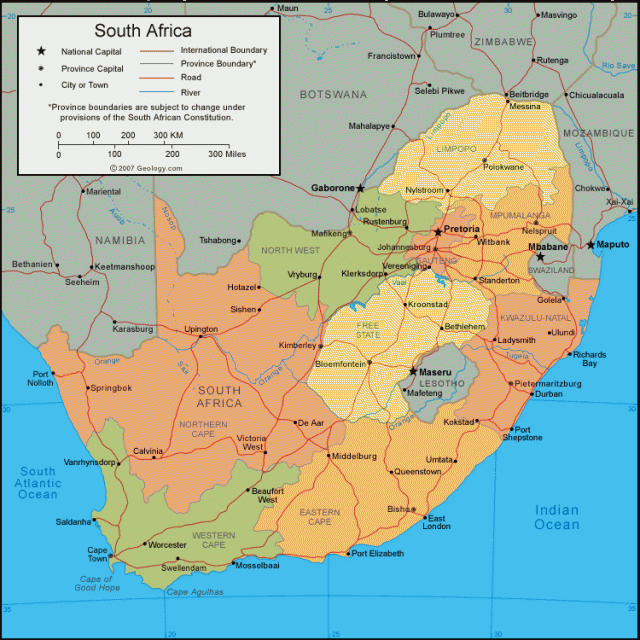South Africa
Area 470,886 square mi (1,219,912 square km)
Capital Pretoria
Population 54.00 million (2014)
Highest Point 11,181 ft (3,408 m)
Lowest Point 0 m
GDP $350.1 billion (2014)
Primary Natural Resources gold, chromium, diamonds, platinum.
OFFICIALLY called the Republic of South Africa, the country is a semiarid subtropical state located on the southernmost tip of Africa. To its north are BOTSWANA, MOZAMBIQUE, and NAMIBIA. To the northeast are SWAZILAND and ZIMBABWE. The ATLANTIC and INDIAN oceans meet at the Cape of Good Hope. LESOTHO, an independent country with an area of 11,717 square mi (30,355 square km), is embedded within the northeastern section of South Africa.

The country is one of the most geographically varied countries of the African continent, comprising territory that ranges from the rolling, fertile plains of the highveld to the wide-open savanna of the Eastern Transvaal to the KALAHARI DESERT and the peaks of the DRAKENSBERG MOUNTAINS.
In addition, nearly all of South Africa's 472,000 square mi (1.2 million square km) lies below the TROPIC OF CAPRICORN. There are three primary geographic regions: an expansive central plateau, a nearly continuous escarpment of mountain ranges that ring the plateau on the west, south, and east, and a narrow strip of low-lying land along the coast. Most of the central plateau (and most of the country) consists of high, rolling grasslands known as highveld. The highest points of the mountainous escarpment are found in the stunning Drakensberg (“dragon's back”) Mountains, where the peaks exceed 10,000 ft (3,050 m) in height.
In the northwest, South Africa's Kalahari Gemsbok National Park, one of the continent's largest game reserves, extends into the red sands and scrub grasslands of the great Kalahari Desert. In contrast, the highveld plateau in the northeast descends to the Bushveld and Limpopo River basins. The Bushveld comprises South Africa's equivalent of the savanna in an area known as the Eastern Transvaal. This marvelous grassland is rich in history and in the diversity of its game such as that found at the world-renowned Kruger National Park.
South Africa has a temperate subtropical climate that varies considerably across its various regions and environments. Temperatures typically remain comfortable throughout the year. Mean annual rainfall varies from less than 8 in (20 cm) in the arid northwest to more than 40 in (100 cm) along the KwaZulu/Natal coast in the southeast. The more fertile agricultural region occupies the narrow coastal plain in the west, south, and east.
The Orange and the Limpopo are the country's principal rivers. Interestingly, South Africa has three capitals, with Cape Town serving as the legislative capital, Pretoria as the administrative capital, and Bloemfontein as the judicial capital, while Johannesburg is the largest city. In addition to the diverse landscape, nothing stands out more about South Africa than its incredible mineral wealth. The country's gold and diamond mines have long been symbols of its wealth and influence on world markets.
Internecine conflict over land rights and colonial authority prevailed among indigenous South Africans and European colonists throughout the 19th century. In 1910, the British Parliament created the Union of South Africa and racial discrimination of indigenous South Africans was formalized. In 1913, for example, the Land Act organized approximately 13 percent of South Africa's total land area into homelands or Bantustans for indigenous South Africans.
After obtaining power in 1948, the predominantly Afrikaner Nationalist Party instituted a rigid system of racial segregation called apartheid that separated the country's ethnic racial groups in various sectors of society. Under the apartheid system, South Africans were classified by racial groups with the Population Registration Act, forced to live in race-specific areas under the Groups Area Act, and dissuaded from interethnic relationships. But black South Africans did not submit to apartheid supinely. They opposed segregation and racism using many political forms and strategies; their most notable organizations were the African National Congress (ANC), the Pan Africanist Congress (PAC), and the Inkatha Freedom Party (IFP). Though their strategies varied, these organizations vehemently opposed the apartheid system. After the Union of South Africa left the English Commonwealth in 1961, repression of antiapartheid activists and activities increased. From 1961 to the 1980s, all South Africans lived in a perpetual state of emergency that allowed the National Party to arrest and imprison Nelson Mandela, the famous ANC leader, and arrest and ban countless others. Political parties were also outlawed and opposition to the apartheid regime was brutally crushed.
Suffering from the debilitating consequences of international isolation, Prime Minister F.W. De Klerk began instituting reforms in 1989. The prohibition of political parties was lifted, Mandela was released from prison, and over the next several years, through a series of political referendums, maneuverings, and compromises, the apartheid system was dismantled. The culmination of these reforms was the first ever-democratic general election in 1994, in which the African National Congress received over 62 percent of the general vote and Mandela was elected president of South Africa.
Not only is it healing its historical apartheid wounds, the country is also striving to cope with the AIDS epidemic. Among the nations of the world, South Africa has the largest population of people infected with HIV/AIDS. Experts estimate that in 2001, five million South Africans lived with HIV/AIDS and approximately 360,000 died from the virus.